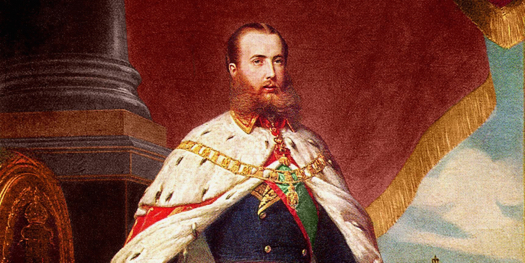The Man Who Would Be Emperor

Reader Goldie wants to know how and why the French came to occupy Mexico in the 1860’s. Goldie, I’d be happy to tell you.
The road from a Spanish territory to an independent nation was a rocky one for Mexico. Though the country gained independence from Spain in 1821, a series of political upheavals followed immediately afterward. First it became the First Mexican Empire, then the United Mexican States, then several different independent nations, then the Second Mexican Empire before it finally settled, more or less, into the nation we now know. That was in 1876.
The period of French intervention in Mexico, known as “The Maximilian Affair”, began in 1861. That was the year that Napoleon III (nephew of Napoleon Bonaparte and second Emperor of France) decided it would be a good idea to begin installing European monarchs in the New World. Mexico, being in disarray after a recent civil war, seemed like a good place to start.
At the time Mexico owed lots of money to France, Spain and Britain, money it had borrowed to fund that civil war I mentioned. When President Benito Juárez stopped payment on the debt in 1861 it gave Napoleon all the pretext he needed to invade. At first the Spaniards and Brits were happy to go along on the adventure. However once it became clear that Napoleon was conducting a war of conquest rather than a simple repo operation, they quickly packed up and went home.
The French fought on. It took them nearly a year and a half, but in time they succeeded in occupying most of the northeast of the country including the capital of Mexico City, which fell on June 7th, 1863. Napoleon’s puppet dictator, Ferdinand Maximilian Joseph, an Austrian and a Habsburg, was installed as Emperor Maximilian I of Mexico on October 3rd of that year.
It’s fair to ask at this point: where was the United States in all this? Wouldn’t the installation of a Hapsburg monarch on our southern border have violated the — what do you call it — Monroe Doctrine? Which is to say, wasn’t it standing US policy not to allow European states to establish new footholds in North, Central or South America? Indeed it was, but as it happened there was a little something else going on in America in the early 1860’s that consumed all our energy and attention: the American Civil War. Because of that the US Government could only stand by and watch as the Napoleon took more and more territory. By 1865 most of what is now Mexico was under French control.
Fortunately for Mexican resistance forces our Civil War ended in 1865, which freed up money and supplies for the cause. Almost immediately American cash, rifles, cannons and ammo began flowing to Benito Juárez’ government in exile. Napoleon quickly realized that the U.S. Government’s next move would be to declare open war upon him. Not willing to risk a conflict on that scale he began to withdraw his troops in the spring of 1866. The new Emperor hung on nonetheless and tried to make a stand with the few forces he had left. However by 1867 republican troops managed to take back Mexico City. Maximilian was summarily executed by firing squad.
Which ended the Maximilian Affair. Still it’s important to remember that the French had managed to hold a good chunk of Mexico for nearly a full six years. Which was plenty of time for imperial bakers to show the locals how to laminate dough.
A story from my youth that stays with me. Maxamillion saw the end coming & sent more than a billion dollars (US) in gold & jewels plundered from Mexico north on a wagon train in barrels marked “flour”. These wagons ran into some Confederate deserters who figured out what was actually being carried. They killed everyone, buried the loot & torched the wagons & bodies. They then ran into some trouble, the survivor claimed Indians but probably in-fighting. A cowboy found the last man alive, before he died of his wounds he drew a map but the cowboy was never able to find it & did not share the original.
If this story is true there is more than a billion dollars waiting for someone to find among the cow crap and tumbleweed of West Texas.
Oh yes I’ve heard of it, Frankly. It’s one of the many treasures thought to be buried in the “Castle Gap” south of Odessa, Texas (Coronado’s gold is another one). From what I understand it’s a true story, though I never heard it was worth that much. Yow. Maybe I’m in the wrong racket. I should give up this blogging thing, buy a shovel and move to West Texas. The odds of making money are a lot better there I’m certain.
Cheers and thanks!
– Joe
I first heard the story when gold was $32/oz & its now north of $1200 last I looked, But I have wondered about that number, it might have grown with the telling.
Its one of three buried treasures I read about as a boy I would like to pursue. There may be a British payroll of silver on one of the Apostle Islands (its allure is proximity) and, of course, Oak Island.
I don’t know the Apostle Islands, but I sure know the Oak Island money pit, it’s fascinated me since I was a kid. I wonder if there’s anything going on there these days. Now I have to go take a look!
– Joe